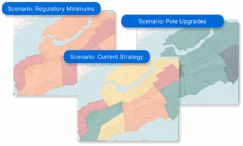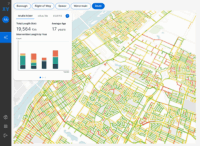How can you plan and create Smart Cities?
Published on November 26th, 2024
Smart cities enhance the quality of life for residents and businesses by embedding technology into daily operations, resulting in a surge of data far beyond what traditional cities produce.
But with this influx of information, how can smart cities transform their data into sustainable, long-term strategies?
Table of Contents
What is a Smart City?
Smart cities leverage technology and data to enhance the efficiency of urban services, improve sustainability, and elevate the quality of life for residents. By integrating tools such as sensors, IoT devices, and data analytics, these cities can gather real-time information about various aspects of urban life—traffic flow, energy usage, public safety, and more.
This data-driven approach allows governments to make informed decisions, optimize resource allocation, and provide more responsive services. From smarter waste management systems to adaptive public transit networks, the goal is to create a more connected, sustainable, and livable urban environment. Additionally, smart city initiatives often stimulate economic growth by fostering innovation and attracting businesses seeking a technologically advanced infrastructure.
What is Smart City technology?
Smart city technology are a suite of solutions used to enhance the functionality, efficiency, and long-term sustainability of urban areas.
And while there are several different options cities can integrate, the most common Smart City technologies are:
Internet of Things (IoT)
The Internet of Things (IoT) are a cornerstone of Smart Cities, comprising a network of connected devices—ranging from sensors in streetlights and traffic systems to smart meters and public transit vehicles.
These “smart objects” are equipped with sensors, software, and network connectivity, enabling them to collect, share, and analyze data in real time.
In a Smart City, IoT devices help optimize urban services, enhance resource management, and improve public safety. Wireless connectivity, including public Wi-Fi, plays a critical role in ensuring the seamless operation of these IoT-powered systems, driving more efficient and responsive city services.
Smart energy
Sustainability is key to smart cities, and achieving it requires efficient, eco-friendly energy management. With urban populations rapidly growing, energy demand often surpasses local resources. A long-term solution is the smart energy chain, which relies on renewable sources like solar and wind to deliver clean energy across cities through a digital, decentralized system.
A prime example is Copenhagen’s EnergyLab Nordhavn project, aimed at carbon neutrality by 2050. The initiative focuses on enhancing grid flexibility with large batteries, electric vehicles, and intelligent heating in 85 homes, benefiting over 7,000 residents.
While promising, smart energy faces challenges, including the accuracy of energy meters and the complexity of integrating the system into larger urban infrastructure. These obstacles make widespread implementation difficult, particularly for developing cities.
Smart mobility
Intelligent mobility is a central element of smart city development, with innovations in multi-modal transportation, smart parking, and traffic management systems reshaping urban travel. This approach integrates traditional transport methods, electric vehicles, and new services like ride-sharing and car-sharing, aiming to improve accessibility, reduce congestion, and enhance overall urban livability.
By optimizing transportation networks through smart technology, cities can offer more efficient, sustainable, and user-friendly solutions for commuting and urban mobility. However, implementing such systems can be challenging, particularly in developing cities, where the high cost of infrastructure and the complexity of planning in densely populated areas often create significant obstacles.
Smart buildings
Smart buildings integrate digital technologies to automate and optimize systems such as lighting, HVAC, security, and energy management. By using real-time data, they enhance energy efficiency, reduce resource consumption, and improve the comfort and safety of occupants.
One of the key advantages of smart buildings is their climate resilience, helping cities adapt to the growing challenges of climate change. These buildings can lower operating costs, simplify maintenance, and contribute to a cleaner, more sustainable environment. However, the widespread adoption of smart buildings faces several challenges, including high initial investment costs, concerns about cybersecurity, the need for proper planning and ongoing maintenance, and potential issues around privacy and data integration.
Smart infrastructure
Smart infrastructure includes not only smart transportation and energy systems but also innovative solutions for utilities like water, as well as the maintenance of essential structures and equipment, such as cables and bridges.
By leveraging sensors and connected devices, data is collected to help decision-makers detect potential issues early, enabling proactive maintenance and improving system efficiency. This approach enhances the reliability of infrastructure, reduces costs, and contributes to a higher quality of life for residents by preventing problems before they become critical.
The challenges of creating Smart Cities
While Smart Cities in the abstract sound like utopic solutions to every day problems, the truth is there are
One of the primary challenges facing Smart Cities is securing the funding necessary to invest in advanced infrastructure, energy solutions, smart buildings, and mobility systems. Developing and maintaining the technologies that power Smart Cities requires significant financial resources, often beyond the capacity of local governments and municipalities.
Smart infrastructure, for example, involves upgrading transportation networks, energy grids, and utility systems to be more efficient and interconnected. These projects are often capital-intensive, requiring long-term investment, yet the return on investment (ROI) may not be immediately apparent, especially in the early stages of development. Additionally, there are challenges in aligning public and private interests to secure funding, as well as ensuring that projects are economically viable and beneficial for all stakeholders.
Moreover, the fast pace of technological innovation means cities must not only find funding for the initial implementation of smart technologies but also for ongoing maintenance, updates, and integration into existing systems. With competing priorities and limited budgets, many cities face the difficult task of prioritizing investments in smart technologies while balancing other essential services.
Let us show you how it works
Our product specialists will walk you through our proven approach to enhance your capital investment planning.

Explore resources
-
 News
NewsDIREXYON Launches GO, an AI-Powered Platform to Streamline Strategic Infrastructure Investments
Read more : DIREXYON Launches GO, an AI-Powered Platform to Streamline Strategic Infrastructure InvestmentsSelf-serve Digital Twin delivers clarity to strategic infrastructure decisions Montreal, QC, September 18, 2025 – DIREXYON Technologies today announced the launch of DIREXYON GO, a self-serve platform that simplifies and accelerates Asset Investment Planning (AIP) for municipalities and utilities. DIREXYON…
-
 E-book
E-bookTurning Wildfire Data into Smarter Investments
Read more : Turning Wildfire Data into Smarter InvestmentsYour wildfire data can do more than predict where fires may spread. It can guide the decisions that protect your grid and your communities. Wildfire threats are rising, regulations are tightening, and budgets are stretched thin. Utilities need more than…
-
 Blog
BlogWhat is Strategic Asset Management?
Read more : What is Strategic Asset Management?Strategic Asset Management is more than a buzzword. It’s a transformative shift in how municipalities and electric utilities manage infrastructure, budgets, and long-term risk. At its core, strategic asset management is about using data to make better decisions. Instead of…